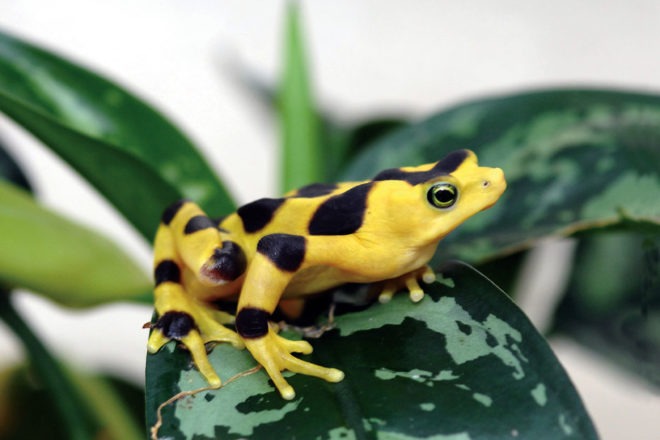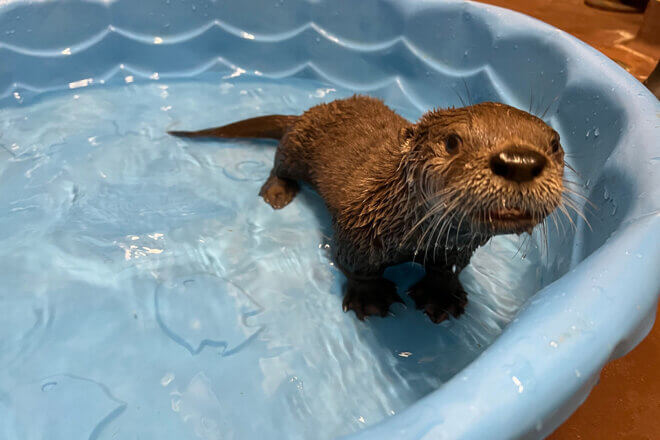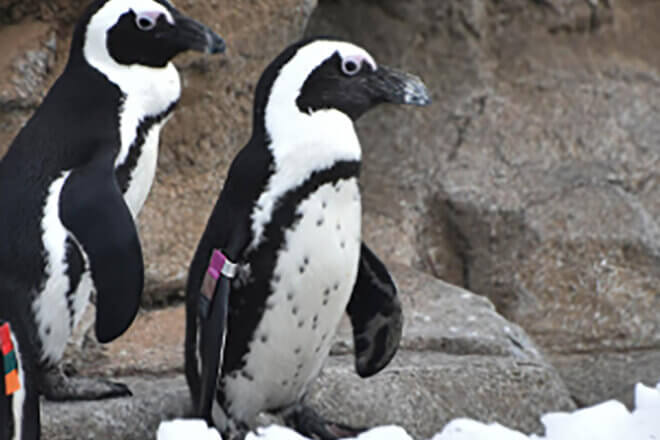Today The Maryland Zoo in Baltimore unveiled its newest exhibit — Panamanian golden frogs. Panamanian golden frogs are among the rarest in the amphibian world, and are considered extinct in their native habitat due to the deadly amphibian chytrid fungus that has spread to their environment.
Panamanians revere the golden frog as a symbol of good luck, and the golden frog likeness appears all over Panama from its currency to lottery tickets.
“For over a decade, The Maryland Zoo has been working behind the scenes to advance research and captive breeding efforts that will preserve the species both in their native land and in Zoos across North America,” stated Don Hutchinson, president/CEO of the Zoo.
“Now, for the first time ever, Zoo guests will be able see golden frogs up close and learn about their plight and what we hope the future holds for them. We are thrilled to be able to share the frogs and their story with our guests.”
The golden frog exhibit is located in The Chimpanzee Forest, directly across from the colobus monkeys, in a specially designed exhibit that stands seven feet tall and four feet wide. “This may not seem large to us,” continued Hutchinson, “But these are very small frogs and it is just perfect for them.”
The bottom of the frog space is set at 24 inches off the ground, so little ones can get nose-to-nose with frogs. The interior is designed to replicate an eroded mud bank where a stream runs, ending in a pool of water.
Orchids, mosses, and other lush tropical plants — many native to Panama — recreate the wild beauty and cover of a high elevation rainforest, as golden frogs come from mountain rainforests where it is cooler.
Plants and rushing water are a huge part of both the natural history of the frogs and are also important for the aesthetics of the exhibit.
The internal workings of the exhibit are state-of-the-art to allow for optimal viewing and environmental control. A reverse osmosis water filtration system removes minerals from the water that would otherwise spot and etch the glass.
The exhibit is not air conditioned, but has a built-in computer that controls certain features that will help cool the exhibit if the temperature rises above the set point. For example, as the temperature rises, the computer will turn on misters and fans, while shutting off certain lights to maintain temperature. In the winter, if the water temperature gets too cold, the computer will turn on a water heater.
Special ultraviolet lights provide the appropriate wavelengths that the frogs need. Next to the exhibit is an electronic education kiosk that serves as a resource for Zoo guests who want to learn about Panamanian golden frogs and what the Zoo is doing to help conserve the species.
There are three videos that provide the back-story on the plight of the frog and focuses attention on what the Maryland Zoo has been doing to preserve this species and why.
For example, golden frog tadpoles help keep the mountain streams clean and fast-moving because they eat only algae. When the frogs are removed from the environment, so are the tadpoles — the algae builds up, clogs streams and slows down the flow of water — throwing the ecosystem out of balance. It is hoped that armed with an awareness of the golden frogs’ story, Zoo guests will be better equipped to one day help conserve other species of amphibians, perhaps in their own back yard.
The Zoo is a founding member of Project Golden Frog, a multinational and multi-institutional conservation initiative that supports research and rescue efforts of golden frogs and other endangered amphibian species in Panama.
“Not only have members of our staff traveled to Panama multiple times to collect the frogs from the wild and to help construct the El Valle Amphibian Conservation Center facility there, but we were also the first to breed these beautiful animals in captivity,” said Hutchinson.
“While nearly 50 Association of Zoos and Aquarium (AZA) accredited institutions in the U.S. and Canada currently have golden frogs in their collections, The Maryland Zoo bred and retains ownership of nearly all of them, and manages the studbook for the population.
”The “Panamanian Golden Frog Conservation Center” is located in the Zoo’s Animal Hospital, where dedicated staff has raised several hundred frogs each year, distributing offspring to other institutions.
“The entire project, including the exhibit and kiosk cost $60,500 and was funded through the generosity of the Jiji Foundation,” concluded Hutchinson. “The exhibit was designed and built by Peeling Productions, and we thank all of our partners for their support for not only the future of the Zoo, but the future of Panamanian golden frogs as well.”






Share this article